
Depending on my mood I see our yard either as a sort of groovy, permacultural exercise in “abundance” or as an overpriced rodent feeder. It occurred to me this morning that we’ve been, inadvertently, running an experimental squirrel fruit buffet for ten years.
Perhaps it would be informative to see what trays in the buffet have any fruit left for the resident hominids. Towards that end, I’ve created an annoying, animated emoticon scale ranging from one to five squirrels with five being the most favored fruits and one being the least favored.
In the give up all hope category:
Figs: ![]()
![]()
![]()
![]()
![]()
Everyone loves figs. Raccoons, squirrels, rats and even Roman emperors. I’ve even seen raccoons, in the middle of the day, feasting on our delicious Mission fig. It’s easy to see why. There’s nothing like a fresh fig. And fig season is so frustratingly short. Kind of like our youth!
Apples: ![]()
![]()
![]()
![]()
![]()
We have two trees, a Winter Banana and a Fuji. The squirrels are welcome to the mealy Winter Banana apples. But those Fujis are just about the tastiest apple I’ve ever eaten. The squirrels usually manage to get them all.
Persimmons: ![]()
![]()
![]()
![]()
![]()
We have both the non-astringent and astringent types of persimmons. The squirrels like to take a bite out of them before they are ripe, thus leaving them to rot on the tree. Persimmons take so long to mature that I doubt I’m going to get any this year before the squirrels get to them.
Peaches: ![]()
![]()
![]()
![]()
I managed to harvest a few thanks to throwing some netting over the tree. But I was so stressed out by the prospect of finding the tree stripped of fruit that I became unpleasant to live with.
On the more hopeful side:
Avocados: ![]()
![]()
The damage here is more from rats than squirrels, I think. Typically, I’ll find an avocado with one bite near the stem on the ground. The good news is that those partially chewed avocados are, usually, still edible.
Pomegranates: ![]()
I think this is the real winner in the squirrel/human fruit buffet fight. I’ve found squirrels trying to eat them but they have to chew through the thick and unappetizing skin. Plus the tree has hidden, wicked thorns. The downside is that these two qualities also make them difficult to harvest and eat. I use what we call the pomegranate spanking method to release the seeds. Squirrels have not yet figured this out.
What fruits do you manage to wrestle from the squirrels? What have you noticed in your garden?

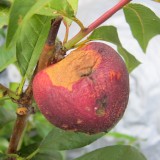
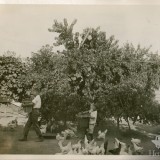
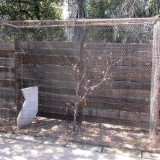
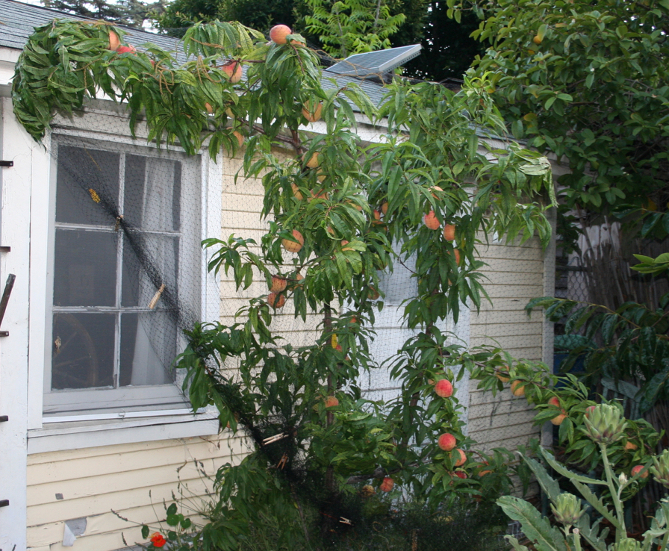
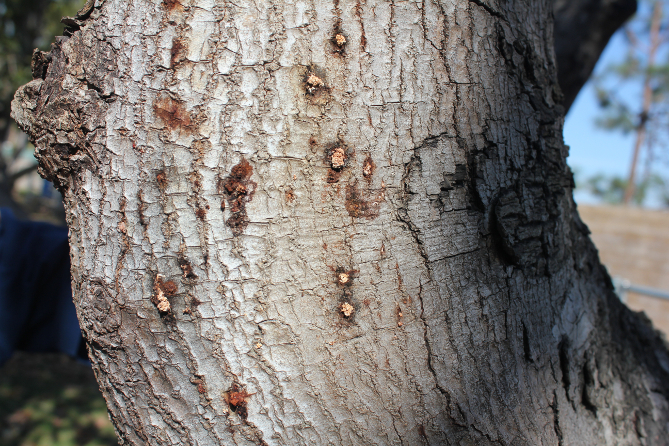

https://instagram.com/p/BK62U-LB6bb/
Caught in the act!
Squirells take out all my avocados and strangely have left everything else mostly alone. I think that’s because most of my fruit is in the front yard where we have lots of human traffic. The avocados are in the back and get lots of bites and knocked out of the tree before they are anywhere near big enough. Could be another rodent but only thing I have seen in the tree is squirrels.
We used to have a wire fence along the property line. Then our neighbors wanted to put up a wooden one. It has a top rail we call the SQUART (Squirrel Area Rapid Transit) because the squirrels now happily run the full length of the property on it without having to come down to the ground between trees. The first year of SQUART they took every single golden delicious apple off the tree. For some reason, this year they’ve left us some. Could be because the neighbor’s walnut has had a good year–who knows? We can only humbly accept the whims of the rodent overlords and gratefully but hastily harvest what they choose to leave us…
The cracked ones , which tend to be at the very top , which i guess are the ones exposed to sunlight the most (I know you’ve written that cracked poms is more an effect of too much or too little watering) , are feasted on by birds.
I imagine the birds enjoying pom seeds, then pooping them out in the nearby hills and eventually I hope these hills near our place will be teeming with pomegranates, so I welcome birds eating the cracked poms very much.
On another note , I noticed the book ad featured along with this article is of that Russian pomegranate expert who eventually moved to Israel (I think he died, no?). But supposedly many of the poms he’d cultivated from around Iran and Afghanistan , many are now on display at UC Davis,
have you guys ever been? I’ve been wanting to, but never had time. Would love for you guys to do a feature of poms from Iran & Afghanistan , tell us if those particular ones grow well in Socal , especially Acton/Palmdale area also.
Also can you guys feature pomegranate orchards around Socal area? I’d love to visit some, but I think most pom orchards are up north. If you know of any around LA county, do share!
Thanks!
Also,
I’m thinking about getting a manual juice press, using it to squeeze out pom juice.
What’s the best manual press out there? Is there a store in the L.A. area where I can test out models for myself? —- at this point I’m stuck reading amazon reviews and have realized all juice press go from 1 to 5 stars w/ equally convincing pro/con reviews,
so I’d love to just go to a store and feel ones for myself, to deduce quality in engineering & design.
Thanks again!
Kevin, you can get and grow the Middle Eastern varieties in Southern California. Laguna Hills Nursery (http://www.lagunahillsnursery.com/) in Santa Ana gets a small selection each year and if they can they will special order any variety they don’t carry. The first of their bare root plants should arrive in 7 weeks and includes the poms: http://files.constantcontact.com/63c1a13a001/18d2d845-ccb9-48d4-872f-af28384280eb.pdf
I’ve had a never ending struggle with these “varmints”. I live in Eastern Ontario and have the Ontario native Walnut trees growing on the property. The little red squirrels are all over the place. I wouldn’t mind that so much, since the walnut meat is too insignificant to use for human food; I assume that the walnuts we buy at the grocery store is Russian Black Walnuts, not what I have. But these guys are trying and have achieved getting into the house (chewing through soffit and facia which I’ve had to redo, and from areas around the old stone foundation of the house which I’ve had to repair. They drive me crazy burying walnuts in all my raised beds and half-barrels that have been planted with carrots and beets. But then there’s rabbits and deer who like these things too.
This might be my favorite post, ever.
I hate squirrels.
After years of losing all of my stone fruit to those pesky red squirrels, I bought a live squirrelinator trap. Bait it with peanuts, catch, relocate, release, end of problem.
https://www.amazon.com/Rugged-Ranch-Products-Squirrelinator-Basin/dp/B0046VE7VM/ref=sr_1_2?ie=UTF8&qid=1475239588&sr=8-2&keywords=squirrelinator
In most areas, it is illegal to relocate wildlife. The point of live traps is to not kill unintended prey.
Did you know that pears are fairly squirrel proof because you can pick them unripe, and unlike apples, they’ll continue to ripen off the tree?
I have three cultivated hazels (Jefferson, Theta, and Tonda di Giffoni) and four native filberts in my yard, and between the squirrels and the jays, we’ve yet to get one lousy nut.
And with two pluots, two Italian plums, three cherries, and eleven apple tree, we don’t get much fruit, either.
I’m pretty sure a rodent-proof fruit doesn’t exist. From what I’ve seen, it’s all relative and varies from year to year. I’m getting NO pomegranates this year, for example, after believing they were somewhat safe. I think that by protecting some of their other favorites, I drove the critters to the poms. I hear a lot of stories about the failure of “rabbit-resistant” plants too – take away the good stuff and they’ll eat almost anything to survive. Of course, we would too…
If we were up against only one pest we might stand a chance. But I protected my almond from squirrels and the birds got the nuts. I caged in my blueberries with chicken wire to keep out the scrub jays and mockingbirds and then the little birds who had been scared away by the big ones got in and ate everything. I put chicken wire under the rock floor of my shed to keep the squirrels from tunneling in, which worked when they tried, but then rats used the tunnels, slipped through the wire and set up shop in our camping gear. I could go on with examples all day, but the point is that growing, and actually harvesting, food can be extremely difficult when you have to compete, directly, with so many wild animals for it. We are at a disadvantage.
Here are a few solutions we’ve found: aluminum flashing rings (~3′ tall) around fruit trees will help keep squirrels out, underground wire baskets will help keep gophers out, and the kind of netting that professional vineyards use will help keep birds out (the cheaper types work too but are such a pain to deal with we gave up on them). But you can see the problem – look at what it would take to even attempt to fully protect a single plant! And none of these techniques are foolproof. We’re on 3.5 acres in rural SoCal with 50 fruit/nut trees, 3000 sq ft of vegetable gardens, and a small vineyard. “Overpriced rodent feeder” indeed! We threaten to sell and move to a condo on a regular basis.
I have raccoons and groundhogs in addition to squirrels and rats. This year, I was not able to grow anything due to health issues.
One year, I bought 120 lbs of sweet potatoes. I left several outside to trim off bad parts. The next morning there was a huge sweet potato about 30 feet up in a crotch in the tree. It had to be a squirrel.
Nothing is safe here. If I had more trees and garden area, I would spend the money to keep my food safe since I just get very ill feeding the wildlife. And, I live in the middle of a small city!
A nearby nursing home is furnishing the rats. People feed the raccoons and groundhogs. Squirrels reproduce like rabbits! Chicken hawks carry off pet cats. Others keep their cats indoors to save them from the hawks. Dogs must be in a yard or on a leash. So, wildlife has a free reign over gardens.
I need a fence and a dog and cats! That would only solve half the problems.
Passion fruit and feijoas have a harder shell and are holding up against the ground squirrels. Mulberries are so prolific they can’t eat them all and blackberries if thornless provide a deterrent.
The squirrels have eaten everything I’ve grown including the Pom tree. They get them when they are still in the flower-ish stage. Heartbreaking.